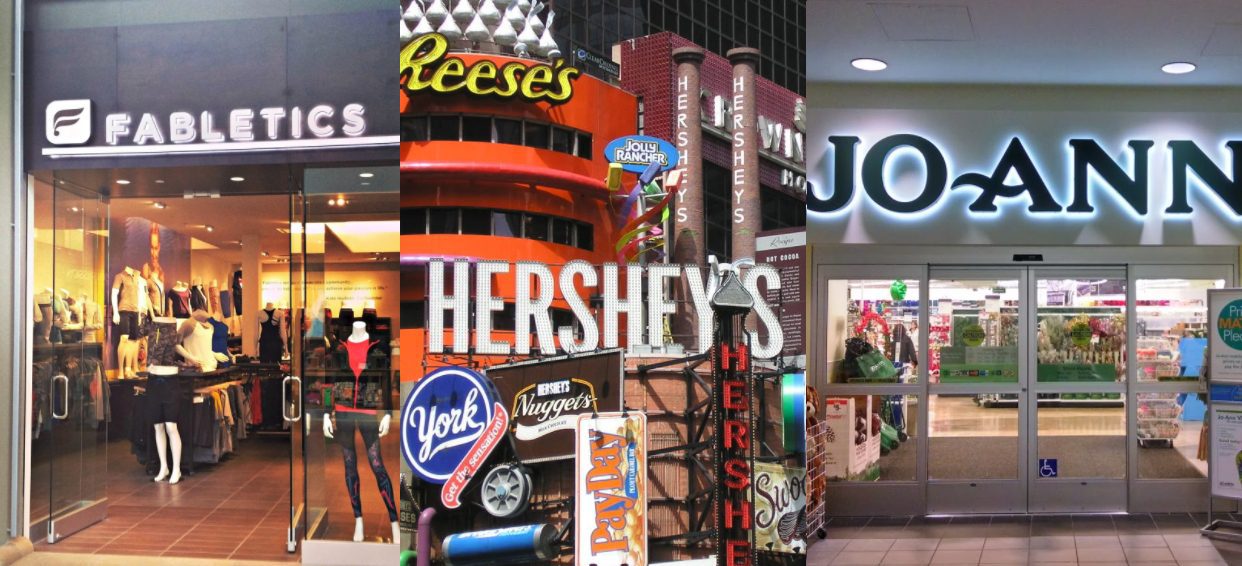The onslaught of bankruptcies and acquisitions is motivating the smartest and most innovative retail businesses to find new ways to capture consumers’ attention, build brand loyalty and deliver on the omnichannel promise.
“I look at it as a time of disruption, not the end of the world,” said Brian Kavanagh, Senior Director, Insights Driven Performance and Retail Evolution, The Hershey Company. “It is waking up sleeping giants” — the traditional retailers and slow movers that have balked at innovation. “They are hard-to-move big battleships, but the jet skis are scooting by them.”
During Shop.org 2017 in Los Angeles, three companies with completely different retail perspectives shared the secrets of their strong business future:
-
The Brand Perspective: Hershey’s
-
The Traditional Store Perspective: Jo-Ann Stores
-
The Online-First Perspective: TechStyle
Hershey’s Counteracts The Demise Of The Impulse Buy
Online grocery ordering has knocked Hershey a bit off its comfortable throne, where shoppers would grab their favorite candies while waiting in the long checkout queue. “We are now working with our retail partners to solve our click-and-collect dilemma,” said Kavanaugh. With $7.4 billion in annual revenue, Hershey’s relies on retail partners, and a handful of its own stores, to keep consumers’ sweet tooth satisfied.
So Hershey’s, along with Coca-Cola and other retail partners, recently conducted consumer research to find a new approach to grabbing the impulse buy. “We wanted to understand what shoppers like and dislike about ordering groceries online…and when is the new best time to remind them” about purchasing their favorite snacks, said Kavanagh. “We need to understand all the different places we need to be in the new shopping journey — during pickup, ordering or in the parking lot.”
Hershey’s also is discovering new potential for infusing innovation into the store experience. Previously, the candy company was able to test and implement new ideas into its handful of Hershey-owned brick-and-mortar stores, including digital technologies and unique experiences. But those innovations were not being embraced by the brand’s retail partners.
With the black cloud of store closures and bankruptcies hanging over the retail segment, traditional retailers are becoming more open to new ideas, Kavanagh noted: “They are looking for ways to differentiate themselves, and that’s giving us more of an ability to work with our retail partners.”
Jo-Ann Stores Incorporates Mobile And Digital Into Its Traditional Retail Model
It’s a tall order to re-invent a 74-year-old brick-and-mortar brand. But Jo-Ann Stores knew that real-time customer data and an integration of online and offline was the key to future success.
A $200 billion retailer with 900 storefronts, Jo-Ann Stores was hanging on to old retail ways that were preventing the business from growing. Then, company executives realized, “If we don’t do it, someone else will,” said Steve Miller, VP, Marketing and Business Development.
The retailer had three specific goals in mind:
1. Enable real-time use cases;
2. Easily stitch together customer data across adtech and martech tools; and
3. Integrate the store and online experiences (currently 95% of Jo-Ann Store transactions are completed in-store).
With a new, digital-first strategy in place, the retailer was able to:
-
Increase online orders by more than 150%;
-
Boost incremental revenue by 18% in two months;
-
Triple reactivation response rates; and
-
Increase in-store transactions with better online engagement.
Partnering with AgilOne, Jo-Ann is now able to identify customer attributes to facilitate more personalized shopping experiences. “We now have data on families with children, income levels, local store, winter and summer locations, likelihood to buy, marital status and more,” Miller explained.
Additionally, by integrating AdTech and martech tools, Jo-Ann can better prospect customers with enhanced lookalike modeling and smarter suppression for retargeting campaigns.
Jo-Ann Stores also added a mobile app, which is being used daily by millions of customers. Today, as much as 75% of the company’s advertising is mobile, according to Miller. With AgilOne, the retailer is able to tie mobile interaction data to an omnichannel customer ID.
Digital-First TechStyle Hits The Streets
Many of today’s digital-first retailers are breaking new ground by opening brick-and-mortar locations. TechStyle Fashion Group, which owns ShoeDazzle, Fabletics, JustFab and FabKids brands, is in the process of opening “many more stores next year,” according to Adam Goldenberg, Co-CEO and Founder of TechStyle. The company has opened 18 Fabletics stores as of mid-2017 and may be adding 80 more in the next few years.
With its digital-first foundation in mind, TechStyle is tapping invaluable data from its stores to help shape new products, pricing and merchandising. The company uses proprietary, internally developed technology solutions to achieve its goals. For example, its patent-pending Omnicart technology ties dressing room items to purchase rates.
“Dressing room data helps with product design and store merchandising, and it ties back to the web site to decide which products to show users,” Goldenberg explained. “We can retarget online shoppers with items they were trying on in the dressing room.”
TechStyle is committed to continuing to develop its own technology solutions. “Leaders in e-Commerce will be on their own platforms,” said Goldenberg. “The biggest reason is that you can attract better talent if they have a blank slate to work with.”
With an in-house team handling visual merchandising and photography, TechStyle is able to test new products and advertising in near-real time. “When we launch a new product, we know in the first 24 hours if it is moving,” said Goldenberg. “If not, we can re-do the photography within 24 hours.”
Additionally, using real-time data, TechStyle tests more than 35,000 different ads each year, and completes up to 3,000 “micro experiences” on the e-Commerce site.
But while keeping most functions internal is working for TechStyle, one area the company is outsourcing is its call center. After a less-than-outstanding experience with a U.S.-based call center, the company moved the unit to the Philippines. “Initially we had a call center near our headquarters that operated 24/7,” Goldenberg explained. But, he added, it was difficult finding committed part-time employees who wanted to work those hours in the U.S.













